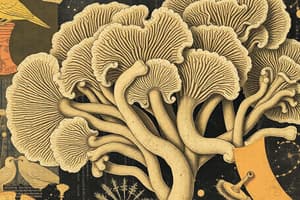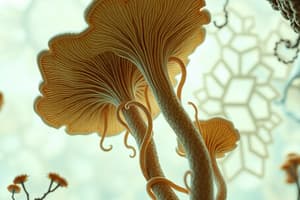Podcast
Questions and Answers
What is the primary purpose of fungal spores?
What is the primary purpose of fungal spores?
- To produce energy through photosynthesis
- To directly participate in nutrient absorption
- To allow the fungus to move to new food sources (correct)
- To enhance reproductive success by forming large colonies
Which of the following best describes the structure of hyphae in fungi?
Which of the following best describes the structure of hyphae in fungi?
- Flat, leaf-like structures that absorb light
- Single-celled organisms with no membranes
- Root-like formations that anchor the fungus in soil
- Multinucleate tubular structures with chitin walls (correct)
How do fungi primarily grow from spores?
How do fungi primarily grow from spores?
- By expanding their cell walls to increase mass
- By means of hyphal growth that expands their surface area (correct)
- Through rapid division of their spores into new cells
- By forming roots that reach out for nutrients
What is a sclerotium in the context of fungi?
What is a sclerotium in the context of fungi?
Which characteristic allows mycelium to thrive in various environments?
Which characteristic allows mycelium to thrive in various environments?
What is a key characteristic of fungi that allows them to decompose organic materials?
What is a key characteristic of fungi that allows them to decompose organic materials?
In which phase do fungi commonly exhibit a haploid state?
In which phase do fungi commonly exhibit a haploid state?
How do fungi like Ascomycota contribute to scientific research?
How do fungi like Ascomycota contribute to scientific research?
Which reproductive method is commonly associated with Basidiomycota fungi?
Which reproductive method is commonly associated with Basidiomycota fungi?
What defines the dikaryotic mycelia stage in certain fungi?
What defines the dikaryotic mycelia stage in certain fungi?
What is a common feature of saprophytic fungi?
What is a common feature of saprophytic fungi?
What is a primary function of hyphal growth in fungi?
What is a primary function of hyphal growth in fungi?
Why are fungi like Armillaria ostoyae significant in ecological terms?
Why are fungi like Armillaria ostoyae significant in ecological terms?
What does a genetic map visualize regarding chromosomes?
What does a genetic map visualize regarding chromosomes?
What limitation is associated with two-point crosses?
What limitation is associated with two-point crosses?
What indicates that two genes are likely located on different chromosomes?
What indicates that two genes are likely located on different chromosomes?
Why is Saccharomyces cerevisiae considered an advantageous model organism?
Why is Saccharomyces cerevisiae considered an advantageous model organism?
During meiosis, what process leads to the exchange of genetic material between chromosomes?
During meiosis, what process leads to the exchange of genetic material between chromosomes?
What is a significant feature of the genome of Saccharomyces cerevisiae?
What is a significant feature of the genome of Saccharomyces cerevisiae?
What type of media is ideal for growing yeast?
What type of media is ideal for growing yeast?
What is a characteristic of linked genes in relation to recombination frequency?
What is a characteristic of linked genes in relation to recombination frequency?
Flashcards are hidden until you start studying
Study Notes
Pathogen Overview
- Pathogens are parasites that cause disease.
- Minimal genome concept raises the question of potential minimal gene design through reductive evolution.
Fungal Structure
- Hyphae are tubular structures with a hard chitin wall, similar to arthropod exoskeletons.
- Cross walls in hyphae may form compartments, allowing for multinucleate structures.
- Hyphae grow at tips, facilitating expansion and exploration.
Fungal Spores
- Spores can be asexual (produced by mitosis) or sexual (produced by meiosis).
- Serve to spread and colonize new food sources.
- Function as a resistant stage, enabling survival during adverse conditions.
- Sclerotium refers to a hardened mass of mycelium that acts as an overwintering stage.
Fungal Body Forms
- Fungi exist in unicellular forms, such as yeasts, and multicellular forms, including mycelial cords and fruit bodies (mushrooms).
- Mycelia have an extensive surface area for nutrient absorption.
- Notable example: A giant Armillaria ostoyae in Oregon spans 3.4 miles, covers 2,200 acres, and is up to 2,400 years old.
Nutritional Mode
- Fungi are heterotrophic, primarily functioning as saprobes (decomposers of dead organic matter).
Ascomycota (Sac Fungi)
- Known for having a completely sequenced genome and a few introns.
- They reproduce sexually via asci and asexually via conidia.
- Serve as important plant parasites, decomposers, and are found in lichens.
- Yeast Saccharomyces serves as a powerful model organism due to conserved genes with humans.
Basidiomycota (Club Fungi)
- Characterized by sexual reproduction through basidia and long-lived dikaryotic mycelia.
- Include mushrooms, rusts, smuts, and other plant parasites.
Yeast Biology
- Yeasts are unicellular fungi that thrive in liquid environments, such as plant saps and moist tissues.
- S. cerevisiae is a model organism with one of the smallest eukaryotic genomes, rapidly grown and easily cultured.
Genetic Linkage and Mapping
- Genetic linkage refers to the inheritance of genes located close to each other on a chromosome.
- A genetic map visually represents the relative positions of genetic markers along a chromosome.
- Limitations of two-point crosses make determining gene order difficult, especially if genes are close together.
Recombination Frequency
- A recombination frequency of 50% suggests that genes are located on different chromosomes and assort independently during meiosis.
- Crossing over during meiosis contributes to genetic diversity by exchanging genetic material between homologous chromosomes.
Studying That Suits You
Use AI to generate personalized quizzes and flashcards to suit your learning preferences.




